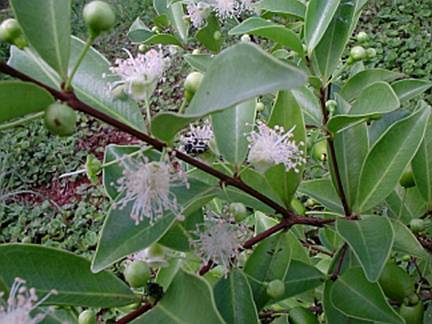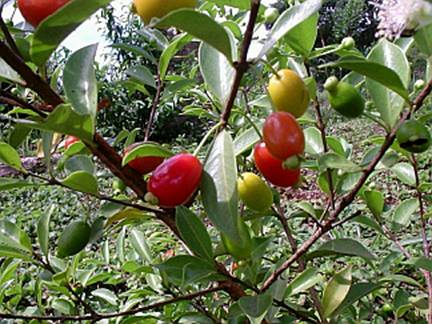EUGENIA OBSERVA
FAMILY OF MYRTACEAE
|
|
|
|
Flowers |
FRUIT |
NATIVE NAME: PITANGA DE PERDIZ comes from the Tupi-Guarani and will say “Fruit of the thin peel”. Also called as Guamirim vermelho do cerrado and Guamirim de perdiz. Formerly this species was classified incorrectly as Eugenia gardneriana.
Origin: Rare species, which spreads in dirty grassland with Goatee and other grasses. Occurs in the states of São Paulo, Mato Grosso do Sul and Minas Gerais in Brazil. More informations in the Portuguese language under the link:
Features: It is a clump-forming shrub that grows from 50 cm to 1 meter high, with small, square, bare (hairless) branches and the bark of the older branches yellowish-brown and cracked. The leaves are simple, opposite and carton-like consistency (similar cardboard), with a shaft (rod or bracket) is very short of 4 to 6 mm in length. The blade measures 6 to 7.8 cm long and 1-2 cm wide, has an elongated shape (longer than wide), based on the acute and long wedge-shaped with a long side and the lower leaf surface is slightly hairy (has white hair) when young. The flowers are hermaphrodite, appear in the axils of leaves on stems (stem or carrier) of 1.2 to 2 cm in length, are white with long stamens (male organs) of 1 to 1.6 cm in length and with pen (female organ), which is even longer. The fruits are drupes up to 1.2 to 2.2 cm in length with a white oval nucleus and 8-9 mm.
Culture tips: It is extremely adaptable to different climatic conditions and can be grown all over Brazil. Can range from sea level up to 1,200 m on soils (yellow or red soil) can be fitted with sandy consistency that are good rain water permeable. It is frost resistant down to -3°C and tolerates drought of up to 3 months without rain. It can be cultivated in pots, and the fruit begins in the age of 1 to 2 years.
Propagation: The seeds are recalcitrant (lose their ability to germinate quickly), so they should be planted within 20 days after harvest. After 40-90 days they germinate and it is recommended to sow individually in bags containing a substrate of 30% sand, 40% red soil and 30% organic matter. They develop where the morning sun shines and should be watered every 2nd day. The seedlings reach 25 cm in 10 months after germination.
Planting: Can be planted in full sun in a spacing of 3 x 3 m, the planting holes should be 50 cm in width, depth and length. They must be filled with 30 cm fertile soil of 7 kg of manure and 2 shovels of gravelly sand, 200 g of lime and 500 g of wood ash. Leave for 2 months and plant in the period from October to December. Then simply irrigate with 10 liters of water after planting and every 15 days if it is not raining. To plant in pots (50 cm high and 40 cm wide), a substrate of 40% red soil, 20% sand and 40% of deposited organic matter should be used, a 4 cm thick layer of stones on the bottom of the pot ensures the rapid drainage.
Culture: The plant grows quickly and requires no special care, just weeds must be weeded regularly, so that the plant does not suffocate. It is not necessary to prune the way. Fertilization with organic compost, it may be 2 kg chicken manure + 20 g of NPK 10-10-10 , spread 5 cm deep and 10 cm from the stem in a circle.
Use: Fruiting from February to May. The fruits can be eaten raw and are very tasty, their taste reminiscent of dragon fruit and persimmons. The flowers produce nectar and pollen for native bees. The plant can be successfully grown in private gardens.
Back to the seedlist (English) or back to Myrtaceae (Portuguese)

